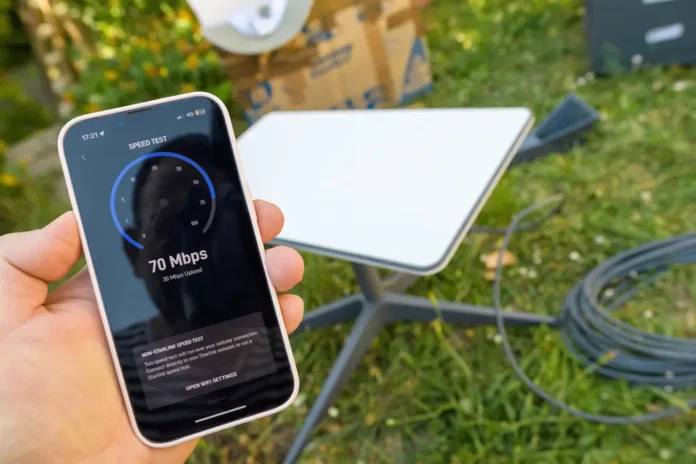If you’re exploring Starlink internet plans, chances are you’re looking for a reliable, high-speed internet option in a location where traditional broadband or fibre connections are unavailable. Starlink, developed by SpaceX, has revolutionized global connectivity by delivering internet through a network of low-Earth orbit (LEO) satellites.
In this detailed guide, we’ll dive deep into what Starlink internet plans offer, how they work, their costs, performance, and which plan might be right for you.
What is Starlink and How It Works
Starlink provides broadband internet access using thousands of satellites orbiting Earth at low altitudes. These satellites communicate with user terminals (dishes) installed on the ground, connecting them to ground stations and the wider internet.
Because the satellites are much closer to Earth than traditional geostationary satellites, Starlink achieves lower latency and higher speeds. The network is continually expanding, meaning better performance and more availability each month.
For users in rural or remote regions, Starlink represents a game-changing alternative to unreliable DSL or costly cellular hotspots.
Why Choose Starlink Internet Plans?
There are several reasons why Starlink internet plans are gaining immense popularity:
- Global coverage: Even remote villages, farms, or mountain cabins can access reliable internet.
- High speed: Users often experience download speeds up to 300 Mbps under ideal conditions.
- Low latency: With latency averaging between 20 – 50 ms, Starlink supports streaming, gaming, and video conferencing smoothly.
- Flexible plans: Whether you’re stationary, on the move, or running a business, there’s a plan suited to your lifestyle.
- Constant improvements: Starlink is adding more satellites and upgrading hardware regularly, enhancing reliability and speed.
If you’ve been struggling with spotty service or slow broadband, these Starlink internet plans can be a reliable upgrade.
Breakdown of Key Starlink Internet Plans
Residential Plans
The Residential plan is the most common among home users.
- Monthly cost: Around $80–$120, depending on region.
- Speed: Typically ranges between 100 – 300 Mbps.
- Equipment: Requires purchasing the Starlink Kit (dish, router, cables).
- Contract: Month-to-month billing with no long-term commitment.
- Data: Generally unlimited, though during peak times heavy users may be deprioritized.
This plan is ideal for families, remote workers, and households that need consistent, high-speed internet for streaming, gaming, and video calls.
Roam / Portable Plans
The Starlink Roam plan caters to travelers and mobile users — RV owners, campers, and adventurers.
- Monthly cost: Around $50 for limited data or $165 for unlimited roaming.
- Portability: Works while moving or parked anywhere within active coverage zones.
- Hardware: The Starlink Mini or standard dish kit; compact and easy to set up.
- Flexibility: You can pause and resume service anytime — perfect for seasonal travelers.
This is the go-to choice for people who live a nomadic lifestyle or need reliable connectivity on the road.
Business / Priority Plans
For enterprises, the Starlink Business or Priority plan offers dedicated bandwidth, better speed, and improved reliability.
- Monthly cost: Higher than residential, often $250 – $500 depending on the data package.
- Speed: Up to 350 Mbps or more, with priority data.
- Equipment: Enhanced antenna with wider field of view and better weather resistance.
- SLA: Some plans include uptime guarantees for critical operations.
This option is perfect for organizations in remote areas, emergency services, field offices, or industrial operations needing reliable, high-capacity internet.
Costs, Hardware & Additional Fees
Before choosing among Starlink internet plans, it’s wise to understand all associated costs:
- Hardware (Dish + Router): Typically a one-time purchase of around $349 – $499.
- Installation: You can self-install, but professional mounting or rooftop placement may add extra cost.
- Monthly Subscription: Ranges between $50 – $500, depending on the plan type.
- Shipping & Handling: May vary by country or region.
- Optional Accessories: Mounting kits, Ethernet adapters, or weatherproof cables can add minor expenses.
Overall, Starlink’s setup cost is higher than a typical ISP, but its reach and flexibility often justify the price for those with no alternative.
Performance: Speeds, Latency & Coverage
Performance varies slightly by location, weather, and network load, but generally, Starlink internet plans provide impressive results:
- Download Speeds: 100 – 300 Mbps (some users report even higher).
- Upload Speeds: 10 – 40 Mbps on average.
- Latency: 20 – 50 milliseconds, suitable for online gaming and real-time communication.
- Coverage: Expanding rapidly; available across most of North America, Europe, parts of Asia, and more regions each quarter.
Because of Starlink’s growing satellite network, coverage is improving monthly, making it an increasingly attractive alternative to traditional internet services.
Availability & Global Expansion
Starlink is now available in dozens of countries, with new regions joining every year. The company’s expansion goal is simple — provide global, high-speed internet access everywhere on Earth.
Even remote areas such as deserts, mountain villages, and oceanic regions are gradually coming online through these Starlink internet plans. Users can check availability by entering their address on the Starlink website and pre-ordering equipment if service hasn’t yet launched in their region.
This global rollout makes Starlink especially appealing for developing countries or rural zones where internet access has historically been limited.
Pros & Cons of Choosing Starlink
Pros
- Global, satellite-based coverage even in rural or remote regions.
- High speeds and relatively low latency for a satellite service.
- Flexible monthly billing with no long-term contracts.
- Portable options for travel and off-grid living.
- Constantly improving technology and infrastructure.
Cons
- Higher initial setup costs compared to traditional ISPs.
- Speed and latency can fluctuate during network congestion.
- Requires clear sky view — trees or tall buildings can obstruct the signal.
- Not yet available in every country or region.
- Business plans can be costly for smaller companies.
Despite these drawbacks, Starlink remains one of the most promising solutions for global internet access.
Tips for Getting the Most from Your Plan
To ensure you get the best results from your chosen Starlink internet plan, follow these practical tips:
- Clear view of the sky: Avoid obstructions like trees or walls that block satellite signals.
- Use the Starlink App: It helps position your dish optimally and monitors performance.
- Select the right plan: Home users don’t need business-grade service unless their workload is critical.
- Upgrade when necessary: New hardware models often improve speed and stability.
- Stay informed: Starlink updates its network and pricing regularly; check for regional improvements.
- Consider power backup: For off-grid setups, use solar or battery backup to maintain uptime.
These steps help maximize performance and reliability for any of the available Starlink internet plans.
Frequently Asked Questions (FAQ)
Q1: What does a typical Starlink plan cost per month?
A: Residential plans generally range from $80 – $120, while Business and Roam plans vary from $50 to over $400 per month.
Q2: Do Starlink internet plans have data limits?
A: Most are advertised as unlimited, but during peak times heavy users might experience reduced priority.
Q3: Can I use Starlink while traveling?
A: Yes, the Roam plan allows mobile use, including in RVs and boats.
Q4: How difficult is installation?
A: Most users can install the system themselves using the provided app. It’s plug-and-play, though a clear sky view is essential.
Q5: Is Starlink available worldwide?
A: Starlink is rapidly expanding, currently covering most of North America, Europe, and parts of Asia and Africa, with more regions joining soon.
Conclusion & Call to Action
In summary, Starlink internet plans have changed how people think about connectivity — offering high-speed, low-latency internet virtually anywhere on Earth. Whether you’re living remotely, traveling full-time, or running a small business in a disconnected region, Starlink provides a viable, modern solution.
If you’re ready to experience reliable, global connectivity, visit Starlink’s official site to check coverage in your area and choose the plan that suits you best.


